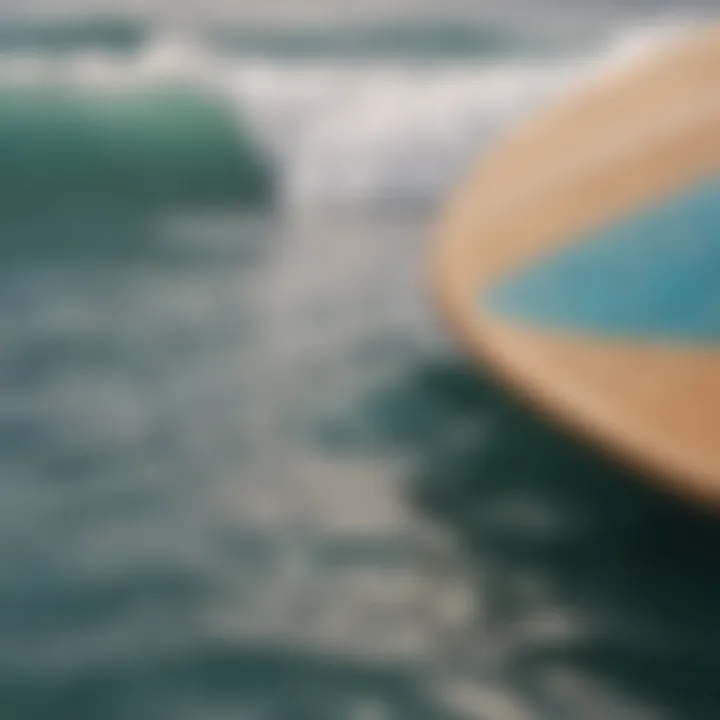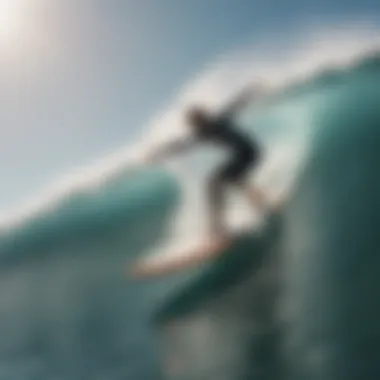Innovative Floating Surfboards: Redefining Performance


Intro
Surfing, a sport that has seen its fair share of innovations over the years, is now at the doorstep of a new era with the introduction of floating surfboards. These revolutionary designs challenge the boundaries of traditional surfing equipment, combining artistry with cutting-edge technology. Imagine effortlessly gliding atop waves, propelled not only by your skill but also through the unique floating mechanics of your board. What was once a simple piece of wood or foam is evolving into a tool that enhances performance and shoreline experiences.
In this discussion, we will unravel how these floating boards work, investigating the buoyancy mechanics and the materials that make them possible. We will also compare them with conventional surfboards, showing the advantages and drawbacks of each. By digging into user experiences, we aim to provide insights that can help surfers, instructors, and eco-minded adventurers alike make informed decisions in their gear choices.
As we journey through the depths of surfing techniques and equipment, we will touch on environmental considerations and the potential future trends that this technology may usher in. Surfers can not only learn about advanced techniques but also gain knowledge on how to adapt their practices to these innovative boards, allowing a seamless transition from the familiar to the extraordinary.
Intro to Floating Surfboards
The introduction of floating surfboards has stirred up quite a buzz in the surfing community, inviting both excitement and skepticism. As adventurers look for ways to enhance their connection with the ocean, entrusting their rides to the ingenuity of floating boards could redefine the surfing experience. This article aims to illuminate the nuances of this innovative equipment, shedding light on its design, implications, and scope of use.
Definition and Purpose
Floating surfboards, as their name suggests, are designed specifically to stay buoyant on water. Unlike traditional boards that rely on a mix of construction and the surfer's weight for stability, floating boards use advanced materials and designs to maintain a higher positioning on the water's surface. This concept not only aims to improve a surfer's performance but also extends the possibilities of surfing itself.
The primary purpose of these boards is to enhance buoyancy, allowing for easier paddling and smoother transitions when catching waves. This means that surfers can adapt to varying conditions with greater ease, whether they're cruising through small breaks or tackling larger swells. Additionally, some enthusiasts find that floating boards provide a safety net, as the added buoyancy offers a greater margin for error during maneuvers.
Historical Background
To fully appreciate where floating surfboards are today, it helps to take a step back in time. The roots of surfing trace back to ancient Polynesia, where early surfers carved boards from solid wood. The lack of buoyancy was compensated by the surfers' skill and balance, making the sport as much about personal connection to the ocean as it was about the equipment.
However, it wasn’t until the early 20th century that innovations began to take shape in board construction. The advent of foam surfboards in the 1960s marked a watershed moment. This shift in materials created lighter boards that floated more effectively than their wooden predecessors. As technological advancements flourished, surfboard design evolved from simple forms to more complex shapes that catered to performance.
Fast forward to the 21st century, floating surfboards began to make a notable appearance, thanks to advancements in materials and an increased understanding of hydrodynamics. Manufacturers began experimenting with various composite materials, leading to boards that didn’t just float better but also performed admirably in a variety of conditions. Throughout this timeline, the surf community witnessed countless adaptations, always in search of improvements that balance functionality with the spirit of the sport.
The journey from traditional to floating surfboards signifies more than just an evolution in design; it showcases the ongoing quest of surfers to blend innovation with tradition. Understanding these developments not only informs potential buyers but also enriches the community’s appreciation for the sport's lineage and future possibilities.
Mechanics of Buoyancy
Understanding the mechanics of buoyancy is at the heart of the design and function of floating surfboards. This concept goes beyond simply keeping equipment afloat; it touches on how these boards interact with water, an element that defines the very sport of surfing. A solid grasp of buoyancy mechanics provides key insights into performance variations, leading to better decision-making for surfers. There’s more to it than just floating; it’s about precision in design that enhances experience on waves.
Principles of Buoyant Force
Buoyant force is the upward thrust that water places on an object submerged within it, working against the pull of gravity. This push comes from differences in pressure, and it’s what keeps floating surfboards supported above water. Essentially, if the buoyant force exceeds the weight of the surfboard, it will float. Calculating this force involves Archimedes’ principle, which states that the buoyant force is equal to the weight of the fluid displaced by the board.
In practice, this principle translates to a strategic approach in surfboard design. Brands are increasingly focusing on optimizing surface area and shape, making sure they can create boards that maximize their buoyancy without weighing them down. When you nail down the principles of buoyancy, you can also appreciate how a slight shift in weight distribution can drastically affect a rider's stability and maneuverability.
Materials Contributing to Floatation
Not all materials are created equal when it comes to keeping a surfboard afloat. A combination of innovative materials has emerged, enhancing buoyancy while ensuring durability and performance. This section unpacks how different types of materials contribute to the overall floatation of these boards.
Foams and Composites
Foams and composites play a significant role in modern surfboard construction. Closed-cell foams, for instance, are lightweight yet incredibly resilient. They trap air and water, allowing the board to maintain its buoyancy. A notable characteristic of these materials is their adaptability; they can be shaped to different designs without sacrificing structural integrity. This flexibility allows surfers to have boards tailored to their personal riding style.
However, not all foams are equal. Some may have great buoyancy but tend to absorb water over time, which can lead to increased weight and diminished performance. A good balance is needed between buoyancy and durability. For example,
- Expanded Polystyrene (EPS) is well-known for its lightweight and floating capabilities, but it is often combined with a resin for added protection and responsiveness during rides.
- Polyurethane (PU) foams, while heavier, provide a blend of excellent buoyancy along with good responsiveness, but they may break down faster in the water if not properly cared for.
Innovative Additives
In the quest for better floatation, manufacturers have started integrating innovative additives into traditional materials. These additives can enhance buoyancy or improve the board’s overall performance. One standout example is hollow core technology, which involves creating cavities within the board structure that reduce weight without sacrificing strength.
A key characteristic of these additives is that they allow for customization. Surfers can get boards that are not only tailored to their specific preferences but also optimized for various wave conditions. This tailored approach means a board designed with such innovations can be markedly more effective in diverse settings.
Additionally, these materials come with their own advantages and disadvantages. For instance,
- Some additives improve the ecological footprint of surfboards, making them a favorable option for environmentally conscious surfers.
- Others may lead to increased manufacturing costs, which can deter some consumers.
"When it comes to the choice of materials, balance is key. You want your board to stay afloat, and being conscious about durability and environmental impact is part of that equation."
Design Innovations in Floating Boards


The world of surfing isn’t just about catching waves; it’s also about how boards are crafted to enhance performance, comfort, and style. Design innovations in floating boards have birthed new opportunities for surfers, changing the way they interact with the ocean. These innovations serve several purposes: improving buoyancy, enhancing stability, and responding to the varied needs of surf enthusiasts. Let’s dive into the specifics of how these boards are shaking things up in the surf community.
Adaptive Shapes and Structures
One of the key factors in the evolution of floating boards is their adaptive shapes and structures. Unlike traditional foam boards, modern floating surfboards often feature dynamic outlines that cater to different surf conditions and rider capabilities. Designers are experimenting with various forms, such as wide tails for better stability or narrow noses that slice through water efficiently. These adaptations allow surfers to tailor their boards to their individual style, making it easier to navigate both choppy waters and smooth swells.
Additionally, some boards utilize techniques like concave shapes, which create a channel effect. This design helps in achieving more lift and making turns sharper. For example, a board with dual concaves might offer enhanced control while performing tricks or navigating tight turns—equipping the rider with a sense of confidence, even in challenging conditions.
Moreover, the structure materials are just as important. High-density foams have been integrated with lightweight composites to create boards that float better without adding excessive weight. This blend of traditional and modern materials not only improves buoyancy but also enhances durability, allowing boards to withstand the rigors of everyday surfing.
Functionality vs Aesthetics
When it comes to surfboards, functionality often takes precedence over aesthetics. However, the latest floating boards showcase that these two aspects can coexist beautifully. Imagine a surfboard that performs exceptionally well, while also being a work of art; this is no longer a distant dream.
Brands are increasingly aware that eye-catching designs can draw in customers while still maintaining essential performance features. Some innovative surfboards sport vivid graphics and custom artwork that express the surfer’s personality. These designs don’t just look great; they also add to the overall experience of surfing, creating a more personal connection to the equipment.
However, achieving the right balance between functionality and aesthetics can be challenging. It requires designers to think critically about how colors and patterns might affect visibility in the water, or how additional elements could alter the board's performance. Keeping the board lightweight yet solid, for instance, is paramount, so designers often opt for finishing techniques that don't compromise structural integrity.
To sum it up, as surfers gravitate towards floating boards, they experience not just a physical change in their equipment but also an aesthetic shift that aligns with today’s eco-conscious and style-savvy market. This progress reflects a broader trend towards celebrating individuality on the waves while embracing the advancements in surfboard technology.
Key Insight: The innovation in surfboard design underscores the dynamic intersection of performance and personal expression, proving that modern surfing gear can cater to both functionality and beauty.
Comparative Analysis: Traditional vs Floating Boards
In the realm of surfing, the evolution of surfboard technology has been a game changer. When surfboards, with their traditional designs, meet innovations like floating boards, it brings about a fascinating point of comparison. This section examines the significant differences between these two types of surfboards, emphasizing how each fulfills specific needs and enhances the surfing experience.
Performance Metrics
When evaluating the performance of surfboards, several metrics hold significant weight. In particular, speed, stability, and maneuverability stand out as key factors influencing surfer preferences.
Speed
Speed in surfing often refers to a surfer's ability to glide smoothly over water, significantly affecting performance. Floating boards generally excel in this area due to their buoyancy. The key characteristic of speed on these boards is their ability to catch waves more efficiently.
A notable feature of speed in floating surfboards arises from their streamlined designs, which allow for reduced drag. This means that surfers can ride waves more quickly and experience a heightened sense of exhilaration. However, some may find that while traditional boards can provide a more "classic" feel, floating boards often offer a more advanced experience, which is appealing to tech-savvy surfers.
Stability
Stability is another critical aspect affecting how a surfer interacts with the board. Floating boards tend to be wider and designed with materials that promote balance. The main takeaway is that their innovative construction results in a heightened level of stability, particularly for novice surfers or those tackling massive waves.
The unique feature of stability in floating boards is the enhanced surface area and the distribution of buoyant materials. This improves the surfer's confidence on the water. However, it might lead some traditionalists to argue that the feel of a traditional board provides an unmatched connection to the ocean, which is somewhat lost in the more buoyant designs.
Maneuverability
Maneuverability speaks to a surfer's ability to make quick turns and adjustments while riding a wave, a vital component in performing tricks or dodging obstacles. Floating boards have been innovatively crafted to enhance this skill, allowing for agile movements without losing speed.
The key characteristic of these boards is their design, which often caters to a more versatile riding style. While traditional boards may provide stability in straight lines, floating boards' versatility can offer adventure lovers the thrill they chase. Nevertheless, some surfers may feel that the extra buoyancy can result in less feedback from the waves, impacting their skill execution.
User Experience
Shifting focus from performance metrics, the user experience becomes paramount in the discourse on traditional versus floating boards. Surfers are always looking for a board that feels right under their feet.
Some may argue that traditional boards foster a deeper sea connection and a more gratifying ride. Surfers often engage in a sentimental attachment to the aesthetics and history of classic boards. Others, conversely, may express eagerness for the innovative features offered by floating boards. User experience is subjective and varies significantly based on personal preference, skill level, and riding style.
In sum, while traditional boards represent the timeless design and craftsmanship of the past, floating boards pave the way for technological advancements and convenience. Each type has its unique characteristics—whether it’s the exhilarating speed, impressive stability, or nimbleness—which go far in shaping how surfers engage with the waves. By understanding these aspects, surfers can better navigate their options, leading to a more informed choice in their surfing journey.
"The choice between traditional and floating boards is as much about personal preference as about performance metrics. Each board type offers a different surfing experience, and it’s essential to find what feels best for you."
This analysis is crucial for surfers, instructors, and eco-enthusiasts alike to think critically about their board choice. The evolution of surfboard design continues to offer exciting opportunities for both seasoned veterans in the surf community and newcomers seeking adventure.
Case Studies: Pioneering Brands
Exploring the innovations brought forth by leading companies in the floating surfboard market sheds light on the dynamics of this evolving sector. Case studies serve as a road map for understanding the practical applications and benefits of floating boards. Through these studies, we can appreciate how pioneering brands have not only embraced technology but have also reshaped the experience of surfing itself.


One crucial aspect to consider is how these brands harness cutting-edge materials and design techniques to distinguish themselves in a competitive environment. Evaluating their unique approaches allows surfers and enthusiasts alike to recognize the potential optimizations for performance, durability, and environmental sustainability in surfboard technology. Most importantly, it emphasizes the real-world impacts of floating surfboards on the user experience, pushing the boundaries of what surfboards can achieve.
Brand A's Innovations
Brand A has made remarkable strides in the floating surfboard realm by emphasizing buoyancy and stability. Their latest model, the "WaveGlider 3000," incorporates a unique hull design that significantly enhances performance on water. The board's advanced engineering ensures that it remains buoyant even in tough conditions, allowing surfers to catch waves more effectively.
One of the standout features is the multi-layered foam composition which not only keeps the board afloat but also adds resilience against the inevitable bumps and scrapes. This makes it a favorite among both seasoned surfers and newcomers. Brand A has also ventured into eco-friendly materials, composing their boards with recycled plastics which helps to lessen the carbon footprint generated by traditional surfboard production.
In terms of user feedback, many riders have concluded that Brand A’s innovations have led to a more fluid and enjoyable surfing experience.
"The WaveGlider 3000 transformed my time on the water. It feels like I’m gliding rather than battling the waves," one satisfied customer remarked.
Brand B's Unique Offerings
Brand B takes a different route with their floating boards, focusing on customization and personalization. Their top model, the "SurfHappy 2K," is designed to cater to individual surf styles and preferences. One of the innovative aspects is the adjustable buoyancy feature, which allows surfers to modify how high the board sits on the water.
This adjustment can significantly impact maneuverability and the type of surf experience a rider desires. For instance, riders venturing into more aggressive wave conditions might opt for lower buoyancy, while those looking for stability might keep it high and agile.
Additionally, Brand B's boards are made from a proprietary blend of hypoallergenic materials that not only benefit the environment but also enhance durability against wear and tear. Surfers have praised Brand B for the seamless integration of tech and surf culture.
Many users rave about the easy interface for adjusting buoyancy, making it accessible for both beginners and advanced surfers alike. Furthermore, Brand B hosts community events to demo their boards, encouraging interaction and engagement among surfing enthusiasts.
Environmental Considerations
The growing trend of floating surfboards is more than just about enhancing performance; it intersects significantly with environmental consciousness. As the surfing community becomes more aware of its impact on marine life and ecosystems, choosing materials and designs that promote sustainability is paramount. This section dives into the nuances that contribute to eco-friendly innovations in surfing gear, along with the broader implications for the oceans that surfboards navigate.
Sustainable Materials
Sustainability in surfboard manufacturing has become a hot topic, especially as surfers are increasingly looking to reduce their ecological footprint. Traditional surfboards, often made from polyurethane and polyester resins, present durability issues while contributing to landfill waste during production and disposal.
In contrast, floating boards are beginning to incorporate materials that are not only recyclable but also derived from sustainable resources. For instance, some manufacturers are experimenting with bio-resins made from plant-derived substances instead of petrochemicals. This shift not only lessens reliance on fossil fuels but also offers a biodegradable solution, lessening long-term environmental pollution.
Additionally, some companies are opting for recycled plastics and EPS core materials which can be sourced from post-consumer products. This kind of upcycling fosters a more circular economy in surfboard production, allowing for reduced waste through reusing materials.
One specific example is the boards created by the brand Firewire Surfboards. They employ an environmentally-friendly manufacturing process known as "Earth Technologies", focusing on sustainable practices from the outset. By investing in such alternatives, surfboards become a more ethical choice for those who cherish the oceans.
Impact on Marine Ecosystems
The ocean's health is intertwined with every surfer's experience. Innovations in surfboard design have the potential to create waves of positive effects on the marine environment, provided that sound ecological practices are followed. Floating surfboards, with their recreational nature, draw attention to how surf products influence the ecosystems where they're used.
Plastic pollution poses a huge threat to marine life, with many species suffering from ingestion or entanglement. As surfboards made from environmentally harmful materials enter the water system, they contribute to this pressing problem. Responsible brands are thus focusing on eco-design strategies to mitigate these harmful effects.
Using sustainable materials not only benefits the manufacturers but also significantly augments the waters where surfing occurs. When floating boards are made using non-toxic and biodegradable components, they lessen the potential for negative interactions with wildlife. This shift in design philosophy encourages more people to enter the sport while fostering a culture of respect for the beautiful oceans they enjoy.
"An eco-friendly surfboard doesn’t just float for performance; it floats for the planet."
In summary, the development of floating surfboards is an opportunity to harmonize surfing and sustainability. As the community leans towards selecting boards that contribute positively both in function and in their ecological impact, surfers can paddle out knowing they’re also protecting the waves they ride. The conversation around environmental considerations is vital, not only for aspiring surfers today but also for the generations that will continue to love the sport in the years to come.
Future Trends in Surfboard Technology
As surfing continues to evolve, so too does the technology behind surfboards. Innovations in materials and design are paving the way for a new era in surfing that enhances not just performance but also the experience itself. By understanding the upcoming trends in surfboard technology, surfers can better align their choices with their goals on the wave.
Emerging Materials
In the world of surfboards, materials play a vital role. Traditional boards often use polyurethane foam and fiberglass, but the shift towards more sustainable and high-performance materials is becoming apparent. Emerging materials such as bio-resins and recycled composites are gaining popularity, aimed at reducing environmental impact while maintaining performance. These materials not only contribute to buoyancy but also offer durability that can withstand the elements.
For instance, some companies have started utilizing plant-based resins that not only help in floatation but are also easier on the planet.
- Advantages:
- Eco-friendly options reduce carbon footprint.
- Lightweight materials enhance speed and maneuverability.
Yet, transitioning to these emerging materials comes with its challenges, including higher production costs and the need for industry adaptation. Nevertheless, the benefits outweigh the drawbacks for those committed to eco-conscious surfing.


Integration of Technology
The integration of technology into surfboards is not just a trend; it's becoming a necessity in the competitive arena. Technology enhances performance and connects surfers to data that can greatly inform their practice.
Smart Boards
Smart boards represent the cutting edge of surfboard innovation, incorporating sensors and tracking devices. This technology allows surfers to monitor their performance metrics in real-time, such as speed, wave height, and even the duration spent on a wave.
- Key characteristic: The ability to collect data directly related to individual surfing performance.
- Benefits:
- Provides insights that can sharpen technique.
- Tracks progress over time, which enhances training efficiency.
However, integrating technology comes with considerations. The initial investment for a smart board can be significant, and some surfers may find it daunting to rely on tech when trying to connect with the natural elements of surfing.
Data Analytics in Board Design
Data analytics in board design takes technology a step further by utilizing surfer data to drive design decisions. This involves analyzing data collected from various riders to inform future surfboard shapes and materials.
- Key characteristic: The ability to tailor designs to meet diverse surfing styles and conditions.
- Benefits:
- Creates custom boards that can optimize performance based on riding style.
- Helps manufacturers understand market trends and surfer preferences, leading to better products.
While this analytical approach can enhance product offerings, it also raises questions about craftsmanship versus data-driven design. The soul of surfing often lies in artistry, and it’s essential for boards to retain that personal touch, even in a tech-driven environment.
"The best board is one that meets the surfer where they are—whether that's on a quiet morning paddle or a competitive heat. Technology should enhance, not overshadow the experience."
The future of surfboards holds tremendous promise, bridging the gap between environment-friendly materials and cutting-edge technology. As advancements continue, surfers should prepare to embrace these innovations, gaining an edge both on the water and for the planet.
Practical Tips for Choosing a Floating Board
Choosing the right floating board can feel like standing at the edge of a vast ocean, with countless options beckoning you. It’s more than just picking a board; it’s about finding one that fits your surfing style, skills, and even your environmental ethics. As the surfing world transitions into these innovative designs, understanding how to select the best floating board becomes essential for enhancing your experience on the waves.
Assessing Skill Levels
When it comes to surfing, your skill level plays a crucial role in the type of floating board you should consider. For newcomers, opting for a board that offers greater stability is paramount; something buoyant enough to keep you upright while you get the hang of paddling and balancing. Look for longer boards, as they typically provide more surface area, allowing for better floatation and easier control.
Conversely, more experienced surfers might prefer shorter boards that emphasize maneuverability. The trade-off is a decrease in stability, but they offer a chance to perform tricks and navigate tighter spaces in the surf. To give a clearer picture, here’s a brief rundown:
- Beginner: Look for longer, wider boards with extra stability.
- Intermediate: Explore mid-length boards that strike a balance.
- Advanced: Shorter boards that enhance agility and speed.
It’s also worthwhile to consider the wave conditions you typically encounter. If you often surf in choppy waters, a board designed for stability will serve you well. On mellow, consistent days, a sleeker model might enable you to flex your skills.
Personal Preferences and Needs
Personal preference extends beyond just skill levels; it encompasses a wider array of factors including shape, color, and even your philosophical approach to surfing. Each surfer will have their own touch, and it’s crucial to find something that feels right beneath your feet.
- Shape: Some surfers might prefer a fish shape for softer waves, while others might lean toward a more traditional shortboard for performance surfing. Find something that resonates with how you ride.
- Brand Ethics: With rising concerns around sustainability, consider brands that prioritize eco-friendly materials. Are they using recycled materials or sustainable practices in their manufacturing? This could greatly influence your choice.
- Design Features: Paid attention to features such as fin configurations. Some offer a greater variety, allowing for experimentation with different styles of surfing. This is especially appealing if you want to mix things up and break out of a routine.
Choosing a floating board is like casting a fishing line into the sea. You’ve got to know what you’re after and what kind of waters you’re navigating. It’s vital to ensure that the board not only complements your skill level but also aligns with your preferences and values.
"The best surfboard is the one that feels like an extension of yourself. It’s about connection—between you, the board, and the waves."
Investing time in understanding these aspects will make all the difference. Whether you’re a casual surfer or someone who lives and breathes surfing, making an informed decision can greatly enhance not just your performance, but your overall joy in riding the waves.
Epilogue and Reflection
In summing up the discussion surrounding floating surfboards, it's clear that the innovations in this area hold significant promise for the surfing community. The development of surfboards that float above the water's surface introduces a myriad of possibilities for both seasoned surfers and novices seeking to elevate their experience. Embracing these advancements means understanding not only how they enhance individual performance but also how they contribute to a broader appreciation of the sport.
Among the notable aspects observed is the impact of buoyancy mechanics on performance. By understanding the principles that enable these boards to maintain their position above water, surfers can gain an edge over traditional designs, favoring agility and stability. Additionally, the sourcing of sustainable materials used in these innovations reflects a growing consciousness towards ecological responsibility, striking a balance between enjoyment and environmental stewardship.
Key insights drawn from this exploration include:
- Performance Enhancement: Floating surfboards often yield improved speed and maneuverability, allowing surfers to navigate waves with ease.
- Broader Access: Superior buoyancy can open up surfing to a more diverse range of individuals who might find traditional boards challenging.
- Adaptive Technology: The fusion of modern technology with board design fosters a new generation of products, further influencing user experiences.
It is not just about adopting new equipment; surfers need to critically evaluate how these boards fit into their personal surf journeys. As we navigate through these innovations, it is crucial to remain open to exploring various options. Understanding how these boards perform in real-world conditions can drive informed decisions, ensuring that each surfer can pick a board that aligns with their skills and style. Whether looking for speed or style, there’s a floating surfboard out there that can meet those criteria.
Exploring new technologies fuels excitement and diversity within the sport. It’s essential to try different models and designs to identify what resonates best.
As we wrap up, I encourage surfers, instructors, and eco-enthusiasts alike to continue experimenting with these floating boards. The surfing landscape is ever-evolving, and being at the forefront of this innovation not only enriches personal experiences but also helps influence the driving trends of the community. By keeping a pulse on new developments and incorporating them into our practice, we can all ride the waves of the future more confidently.















